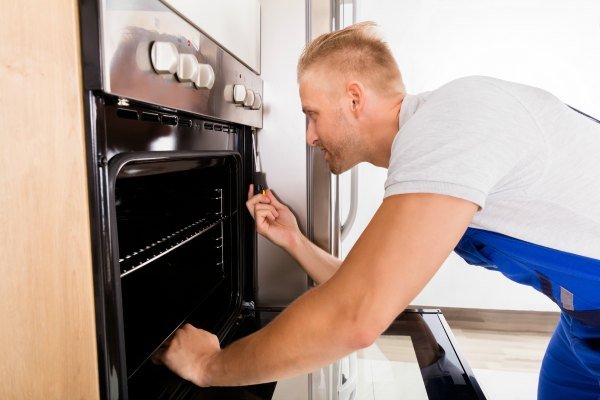Why Is My Electric Oven Not Heating Up? 5 Causes and Solutions

1. A Tripped Circuit Breaker
Most electric ovens run on 240 volts, which is why they usually need their own circuit and outlet. Sometimes, turning the oven on can trip the breaker, stopping the power flow. This may be caused by a simple glitch or a more serious problem, such as a wiring issue.
The Solution
Check your breaker panel for the switch connected to the oven and turn it back on to reset it. If the oven continues to shut off or won’t heat, it’s wise to call a local appliance repair expert, as the issue may involve wiring or an internal component that requires professional service.
2. A Broken Thermostat
An oven uses a thermostat or temperature sensor to track its internal heat and maintain the set temperature. If this part fails, the oven may misread the actual temperature and shut off prematurely, thinking it has already reached the desired heat.
The Solution
Inside the oven, the temperature sensor usually appears as a thin rod near the back wall. It needs to stay positioned at the correct angle to measure heat accurately, but over time it can become displaced. If that occurs, gently move it back into place. If you’re unsure about its alignment or can’t find it, contacting a skilled appliance technician from Appliance SD Repair is recommended.
3. A Broken Heating Element
Most electric ovens have heating coils located on the top and bottom, which turn red when active. If one of these coils malfunctions, the oven may fail to reach the desired temperature or may not heat at all. Signs of a faulty element can include visible damage like cracks or blisters, and in some cases, accumulated dirt or grease can also reduce its effectiveness.
The Solution
Keeping your electric oven clean—either using its self-cleaning mode or by manual scrubbing—helps maintain the efficiency and lifespan of the heating elements. If an element is damaged beyond repair, it will need to be replaced. Although replacing it yourself is possible, having a professional technician from Appliance SD Repair perform the work is usually the safer choice.
4. The Oven’s Knobs Are Misaligned
Even though many modern electric ovens now use digital controls and push buttons, traditional temperature knobs are still present on numerous models. Similar to the internal temperature sensor, these external knobs can occasionally become misaligned, preventing the oven from reaching the correct temperature.
The Solution
If a temperature knob is not functioning properly, replacing it may resolve the issue. Inspect the knobs for visible damage, such as cracks, or buildup of dirt that could make them stick or turn unevenly. Replacement knobs are usually easy to obtain, either from online retailers or local appliance stores, depending on your oven’s brand and model.
5. The Door Doesn’t Seal
Similar to keeping your front door closed in winter to retain heat, it’s crucial to keep the oven door shut while cooking. Leaving it open allows heat to escape, making it seem like the oven isn’t heating correctly. A pan that’s too large can prevent the door from closing completely, and a worn or dirty door seal could also reduce heat retention.
The Solution
Whenever you use your oven, make sure the door is fully closed and that your pans or baking trays fit properly. If you think the problem lies with the door seal, examine it carefully. Grease or dirt buildup can affect its performance, and over time the seal may wear out. Replacing a damaged or dirty seal can restore proper closure and help maintain consistent oven heat.
Signs of Oven Temperature Trouble
A noticeable sign of a temperature issue is when the oven fails to heat. Sometimes, it may heat unevenly or struggle to reach the set temperature. Indicators of this problem include:
- Meals taking longer to cook or bake than normal
- Food cooking unevenly, with some parts overcooked while others remain undercooked
- Heating elements not glowing the typical orange-red color
When to Call a Pro
If you’re uncertain about resetting a tripped circuit or adjusting the thermostat on your own, it’s best to contact a professional. A qualified technician can evaluate the problem and recommend the most effective course of action, whether that’s repairing components or replacing the oven.
Alpine Ca, Bonita Ca, Camp Pendleton Ca, Coronado Ca, Del Mar Ca, El Cajon Ca, Encinitas Ca, Escondido Ca, Imperial Beach Ca, Cardiff Ca, Carlsbad Ca, Chula Vista Ca, La Jolla Ca, La Mesa Ca, Lakeside Ca, Lemon Grove Ca, National City Ca, Oceanside Ca, Pacific Beach Ca, Point Loma Ca, Poway Ca, Ramona Ca, Rancho Bernardo Ca, Rancho Penasquitos Ca, Rancho San Diego Ca, Rancho Santa Fe Ca, San Marcos Ca, San Ysidro Ca, Santee Ca, Solana Beach Ca, Spring Valley Ca, Vista Ca Refrigerator repair, Freezer repair, Ice-maker repair, Wine-cooler repair, Washer repair, Dryer repair, Dishwasher repair, Stove repair, Oven repair, Range repairAreas that we cover:
Services that we provide
REQUEST SERVICE
Book a Repair Appointment

You can find us here
